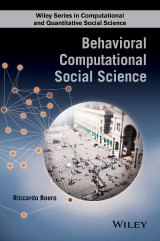Details

Behavioral Computational Social Science
Wiley Series in Computational and Quantitative Social Science 1. Aufl.
|
62,99 € |
|
| Verlag: | Wiley |
| Format: | EPUB |
| Veröffentl.: | 21.07.2015 |
| ISBN/EAN: | 9781119106159 |
| Sprache: | englisch |
| Anzahl Seiten: | 200 |
DRM-geschütztes eBook, Sie benötigen z.B. Adobe Digital Editions und eine Adobe ID zum Lesen.
Beschreibungen
This book is organized in two parts: the first part introduces the reader to all the concepts, tools and references that are required to start conducting research in behavioral computational social science. The methodological reasons for integrating the two approaches are also presented from the individual and separated viewpoints of the two approaches.The second part of the book, presents all the advanced methodological and technical aspects that are relevant for the proposed integration. Several contributions which effectively merge the computational and the behavioral approaches are presented and discussed throughout
<p>Preface ix</p> <p><b>1 Introduction: Toward behavioral computational social science 1</b></p> <p>1.1 Research strategies in CSS 2</p> <p>1.2 Why behavioral CSS 3</p> <p>1.3 Organization of the book 4</p> <p><b>Part i CONCEPTS AND METHODS 7</b></p> <p><b>2 Explanation in computational social science 9</b></p> <p>2.1 Concepts 10</p> <p>2.1.1 Causality 10</p> <p>2.1.2 Data 18</p> <p>2.2 Methods 19</p> <p>2.2.1 ABMs 19</p> <p>2.2.2 Statistical mechanics, system dynamics, and cellular automata 22</p> <p>2.3 Tools 25</p> <p>2.4 Critical issues: Uncertainty, model communication 27</p> <p><b>3 Observation and explanation in behavioral sciences 31</b></p> <p>3.1 Concepts 32</p> <p>3.2 Observation methods 35</p> <p>3.2.1 Naturalistic observation and case studies 35</p> <p>3.2.2 Surveys 36</p> <p>3.2.3 Experiments and quasiexperiments 37</p> <p>3.3 Tools 38</p> <p>3.4 Critical issues: Induced responses, external validity, and replicability 40</p> <p><b>4 Reasons for integration 43</b></p> <p>4.1 The perspective of agent?]based modelers 44</p> <p>4.2 The perspective of behavioral social scientists 49</p> <p>4.3 The perspective of social sciences in general 54</p> <p><b>Part iI BEHAVIORAL COMPUTATIONAL SOCIAL SCIENCE IN PRACTICE 57</b></p> <p><b>5 Behavioral agents 59</b></p> <p>5.1 Measurement scales of data 61</p> <p>5.2 Model calibration 63</p> <p>5.2.1 Single decision variable and simple decision function 63</p> <p>5.2.2 Multiple decision variables and multilevel decision trees 65</p> <p>5.3 Model classification 67</p> <p>5.4 Critical issues: Validation, uncertainty modeling 70</p> <p><b>6 Sophisticated agents 73</b></p> <p>6.1 Common features of sophisticated agents 75</p> <p>6.2 Cognitive processes 75</p> <p>6.2.1 Reinforcement learning 76</p> <p>6.2.2 Other models of bounded rationality 80</p> <p>6.2.3 Nature?]inspired algorithms 80</p> <p>6.3 Cognitive structures 84</p> <p>6.3.1 Middle?]level structures 85</p> <p>6.3.2 Rich cognitive models 86</p> <p>6.4 Critical issues: Calibration, validation, robustness, social interface 88</p> <p><b>7 Social networks and other interaction structures 91</b></p> <p>7.1 Essential elements of SNA 93</p> <p>7.2 Models for the generation of social networks 99</p> <p>7.3 Other kinds of interaction structures 104</p> <p>7.4 Critical issues: Time and behavior 106</p> <p><b>8 An example of application 109</b></p> <p>8.1 The social dilemma 110</p> <p>8.1.1 The theory 111</p> <p>8.1.2 Evidence 113</p> <p>8.1.3 Our research agenda 114</p> <p>8.2 The original experiment 114</p> <p>8.3 Behavioral agents 116</p> <p>8.3.1 Fixed effects model 116</p> <p>8.3.2 Random coefficients model 117</p> <p>8.3.3 First differences model 118</p> <p>8.3.4 Ordered probit model with individual dummies 119</p> <p>8.3.5 Multilevel decision trees 121</p> <p>8.3.6 Classified heuristics 126</p> <p>8.4 Learning agents 127</p> <p>8.5 Interaction structures 127</p> <p>8.6 Results: Answers to a few research questions 128</p> <p>8.6.1 Are all models of agents capable of replicating the experiment? 129</p> <p>8.6.2 Was the experiment influenced by chance? 131</p> <p>8.6.3 Do economic incentives work? 133</p> <p>8.6.4 Why does increasing group size generate more cooperation? 135</p> <p>8.6.5 What happens with longer interaction? 136</p> <p>8.6.6 Does a realistic social network promote cooperation? 137</p> <p>8.7 Conclusions 138</p> <p>Appendix Technical guide to the example model 141</p> <p>A.1 The interface 142</p> <p>A.2 The code 145</p> <p>A.2.1 Variable declaration 146</p> <p>A.2.2 Simulation setup 152</p> <p>A.2.3 Running the simulation 157</p> <p>A.2.4 Decision-making 157</p> <p>A.2.5 Updating interaction structure and other variables 165</p> <p>References 173</p> <p>Index 187</p>
<p><b>Riccardo Boero</b>, Economics and Market Analysis Team, Energy and Infrastructure Analysis Group, Los Alasmos National Laboratory, USA</p>
<p>New computational and experimental approaches to social science present both opportunities and challenges. These approaches can provide new and more robust insights on several important social phenomena, but they require crossing many methodological and technical boundaries, including those that<br />have been established most recently.</p> <p>Behavioral Computational Social Science presents a comprehensive framework that couples behavioral analysis with the advanced modeling features typical of computational social science. The methodology presented allows the extension of the analytical power of the single tools composing it and provides a consistent approach for investigating the different components of the mechanisms explaining social phenomena.</p> <p>Key features:<br /><br />• Introduces the most recent methods for behavioral analysis and computational modeling in social sciences.</p> <p>• Presents the combined usage of both behavioral analysis and computational modeling tools, along with detailed descriptions of how to combine the usage of these tools.</p> <p>• Highlights the advantages of the conjoint approach and explores the issues that researchers have to face using state-of-the-art references and examples.</p> <p>• Provides guidance for readers who are new to behavioral and computational tools, while also providing invaluable information for experts in the field</p> <p>This book enables the reader to effectively integrate behavioral analysis and computational modeling in social science research. Graduate students and researchers interested in enriching their analytical toolset will benefit from this book.</p>
Diese Produkte könnten Sie auch interessieren:

Nonparametric Regression Methods for Longitudinal Data Analysis

von: Hulin Wu, Jin-Ting Zhang

135,99 €

Statistics and the Evaluation of Evidence for Forensic Scientists

von: Colin Aitken, Franco Taroni

103,99 €














